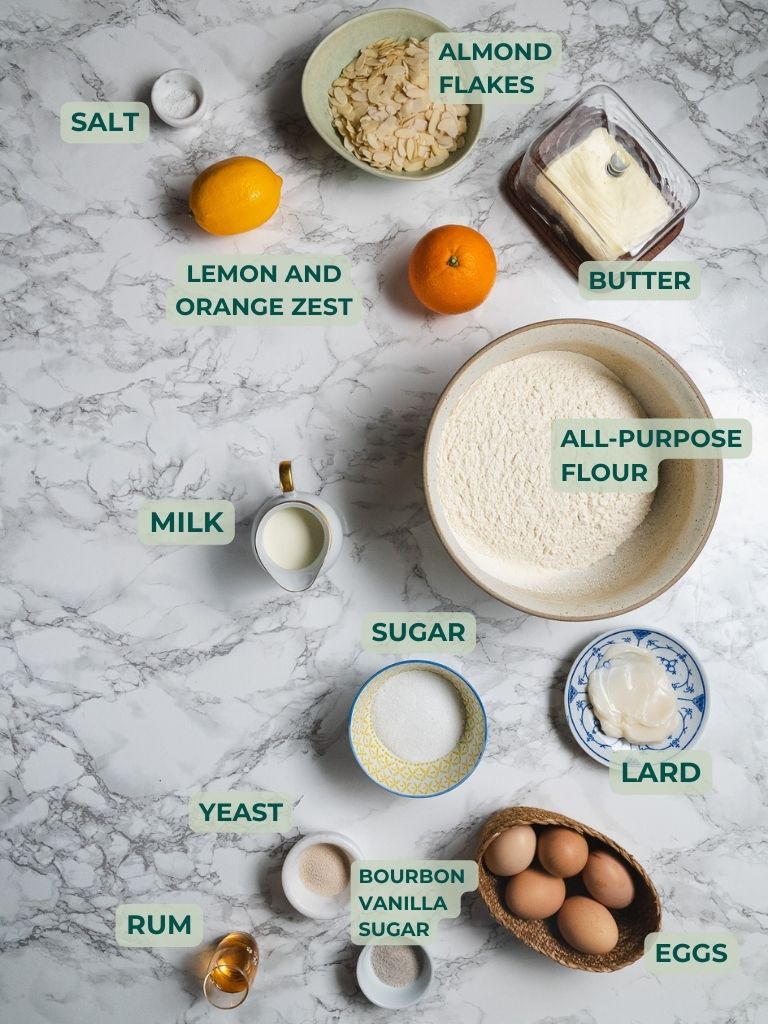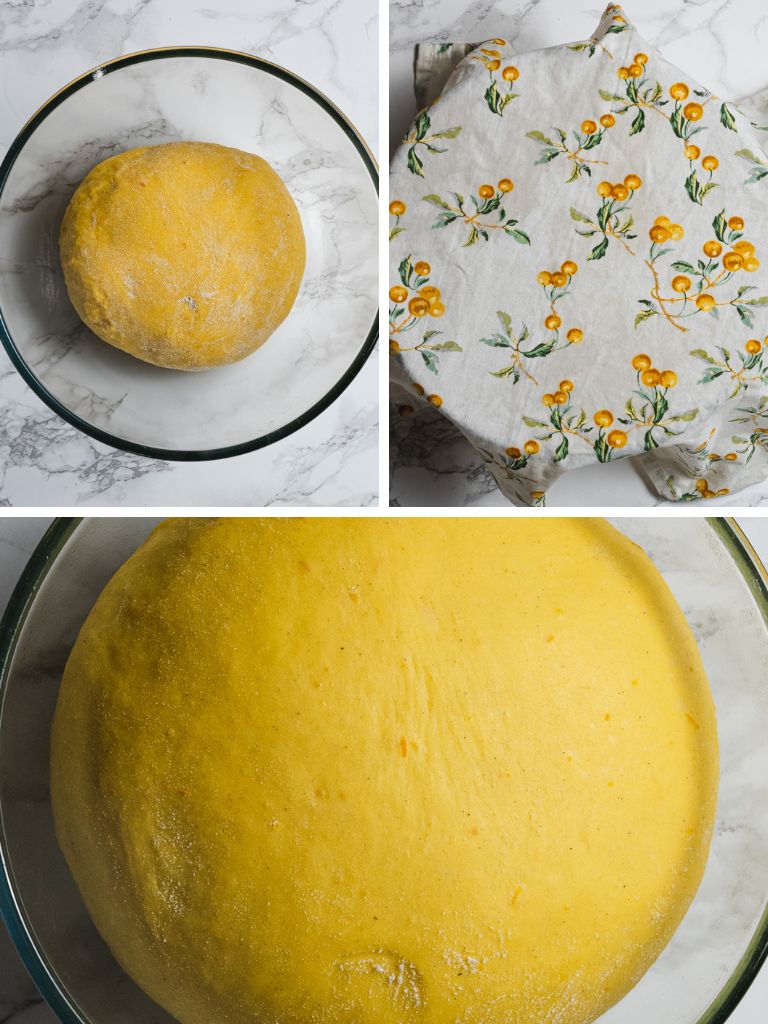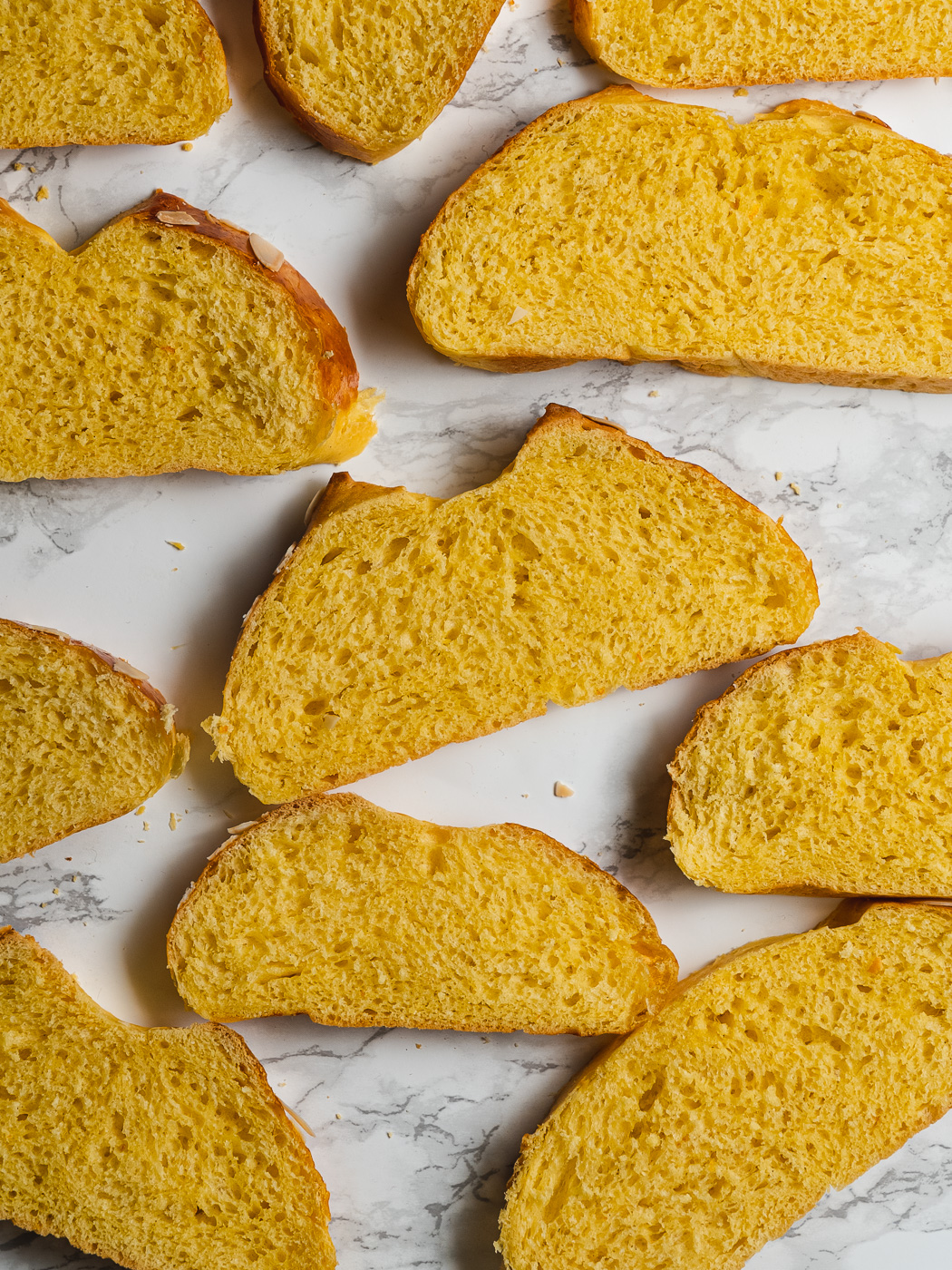Table of Contents
What is Pinca (Sirnica)
Every holiday season, we traditionally always return to certain recipes, right? For Christmas, we love to make a certain type of cookies and cakes, for Mardi Gras the whole country enjoys some doughnuts (krafne or krofne as we like to call them in Croatia), and for Easter, we bake and eat pinca bread.
Pinca (also called sirnica or kvasnica) is an aromatic sweet bread, characteristic of the Istria, Dalmatia, and the Croatian Littoral region. It’s so good that even we who live in other parts of Croatia have started to bake this bread regularly for every Easter!

Pinca Easter bread is made from enriched yeast dough, similar to brioche. Its amazing yellow color comes from free-range eggs and egg yolk, and its incredible aroma is due to the orange and lemon zest and additions of different types of alcohol, like rum or rose liqueur.
Easter pinca bread has a reputation as bread that’s not that easy to make, but with a little patience, a lot of love, and effort, the result will be perfect. I suggest you read through this post and recipe for pinca carefully and follow all the steps, and I guarantee that you’ll make a wonderful Easter bread that your family will enjoy.
I published this recipe for the first time on my blog back in 2018, and it was inspired by the recipe of our famous pastry chef Petra Jelenić. Your many photos and comments every year in the run-up to Easter have encouraged me to bring this recipe closer to you, clarify it, and make it easier to prepare.
Ingredients for Croatian Easter Pinca Bread

- Flour – you need all-purpose flour, sifted.
- Yeast – I use active dry yeast that is specifically made to be used in enriched dough like this, but if you can’t find this type of yeast in your country, you can use regular active dry yeast instead. Just increase the amount to 10 g. The third option is to use 25 g of fresh yeast. You need to dissolve it in warm milk beforehand.
- Fats – pinca bread is traditionally rich in various fats. I like to combine butter and lard, but you can opt for high-quality olive oil, too. Just stick to the total amount of fat needed for this dough.
- Sugar – some people like very sweet pinca bread, some people don’t. I’m in the second group, so I don’t use too much sugar in my Easter pinca bread. If you want, you can also add a bit of honey to the dough for a more complex flavor.
- Eggs and egg yolks – bind all the ingredients, make the dough fluffier and lighter, and give an amazing yellow color.
- Rum – gives a wonderful aroma. This is a part where you can experiment the most: use orange liqueur, limoncello, rose liqueur, maraschino, or even Slivovitz. Use the type of alcohol whose aroma you enjoy the most or simply the one that is available to you.
- Milk – for binding all the ingredients and for dissolving the yeast, if you’ll be using fresh yeast. If the dough seems dry during the kneading stage, you can add a splash of milk or two.
- Salt – for flavor.
- Citrus zest – I always combine freshly grated orange and lemon zest when making pinca. They need to be organic. Instead, you can use high-quality extracts of lemon and orange.
How To Make A Croatian Easter Bread Pinca
Be sure to check out the recipe card at the end of this post. It has the exact amounts of ingredients and detailed recipe instructions!
1. STEP: Making the dough
In a bowl of a standing mixer add sifted flour, yeast, both types of sugar, salt, butter, and lard, and start kneading with the dough hook attachment on the lowest speed.

2. STEP: Making the dough
Beat the eggs, yolks, and milk with a whisk and start adding them to the bowl of a standing mixer. Add rum and citrus zest. Knead the dough for about 10 minutes or so.

3. STEP: Proofing the dough
Transfer the dough to a bowl to rise, cover, and let it double in size.

4. STEP: Shaping pinca Easter bread and second proofing
After the first rise, knead the dough again and then divide it into 3 balls (or more, if you want smaller pinca breads). Transfer to a baking sheet, cover again, and let them rest at least for another 1h.



5. STEP: Make cuts
When pinca bread has risen, make cuts in the shape of the cross. I usually do this step with kitchen scissors. Then brush with beaten egg yolk.

6. STEP: Final touch
Sprinkle with almond flakes or pearl sugar.

7. STEP: Baking
Bake at 160°C for 25-35 minutes, depending on the site of the pinca bread and your oven. If you see that the pincas suddenly start to get too dark in color, cover them with aluminum foil.
8. STEP: Serving
When the pinca is baked, take it out of the oven and transfer it to a cooling rack to cool completely. Then it’s ready for cutting and serving. Dobar tek!


Best Pinca Easter Bread – Tips And Tricks
- All ingredients should be at room temperature and prepared upfront. You can heat the milk a bit (but it shouldn’t be too hot, otherwise it will kill the yeast).
- Since pinca belongs to the enriched type of dough, I like to use a special type of active dry yeast that is specifically made to be used for this type of dough. It allows this sweet Easter bread to rise faster. If not available to you, use regular active dry yeast or fresh yeast (that needs to be dissolved in the milk).
- If you cannot find organic lemons and oranges, instead you can use high-quality extracts. Never ever use the zest of citrus fruit that was treated with imazalil.
- If you haven’t had the opportunity to experience the therapeutic effect of kneading the dough, you’ll experience that feeling while making pinca. The dough should be well kneaded so that gluten can be developed. That will give pinca that beautiful velvety texture and smoothness.
- Avoid adding extra flour during the kneading process.
- You can enrich this sweet Easter bread with dried fruit, like raisins, figs, apricots, etc. You can also experiment with the alcohol; instead of rum, you can add some good liqueur or even limoncello.
- Pinca can easily burn in the oven during baking. Don’t bake it for too long or at a too high temperature, otherwise, it can become dry inside. If the crust starts getting too dark, cover it with aluminum foil so it doesn’t burn. Pinca is baked when you insert a toothpick in the middle of the bread, and it comes out completely clean.

Pinca can be also made in mini versions, like brioche burger buns. In the photo below, you can see how they looked when I made them in 2019. They were adorable!

Frequently Asked Questions
Of course, it can, just like any other bread made with baker’s yeast.
The main culprit was probably old yeast with an expired date or the milk was way too hot.
Pearl sugar is a decorative type of thermostable sugar, which means it won’t melt in the oven. Baked goods like cinnamon rolls, pinca Easter bread, or Easter Dove are often sprinkled with pearl sugar before baking. Instead of pearl sugar, I like to use almond flakes when making pincas.
Pinca will remain soft and delicious even on the third day after baking, but it is important to store it right. If you are not going to eat it immediately after baking, I suggest that while it is still warm, you wrap it in transparent plastic film and then put it in a reusable zip bag and store it at room temperature.
Note: This post was originally published for the first time in 2018. In the meantime, the article has been updated twice with new information, tips, and photos in 2019 and 2024. All these years, I baked pinca countless times according to this recipe, and it was always a big success.
If you try this recipe, tag @foodandmoodblog on Instagram or leave your comment and rating of this recipe here on the blog. I would love to hear from you!

Pinca – Soft and Sweet Croatian Easter Bread
Ingredients
DOUGH
- 500 g all-purpose flour sifted
- 8 g active or instant dry yeast please, read through post for more info
- 60 g white granulated sugar
- 10 g bourbon vanilla sugar
- ½ teaspoon salt
- 50 g butter unsalted
- 50 g lard
- 2 eggs
- 3 egg yolks
- 1 dcl milk
- 1,5 tablespoon rum
- 1 teaspoon orange zest freshly grated
- 1 teaspoon lemon zest freshly grated
BRUSHING
- 1 egg yolk for brushing pinca before baking
- almond flakes or pearl sugar
Instructions
- In a bowl of a standing mixer combine sifted flour, yeast, regular and vanilla sugar, salt, lard, and butter. Start the kneading process at the lowest speed.
- While kneading, slowly start to pour previously whisked eggs, egg yolks, and milk. Then add rum and grated orange and lemon zest. Keep kneading the dough for about 10 minutes, hen transfer it to a lightly floured surface and form the dough into a ball.
- Transfer the dough to a floured bowl, cover it with a damp kitchen towel or cling foil, and let it rise in a warm place until doubles in size. That should take from 1,5 to 2 hours.
- After it has doubled in size, take the dough out of the bowl and knead again on a working surface, for 10 minutes more. Divide and shape into 3 balls (or more, if you want smaller pincas) and transfer to a baking tray covered with parchment paper. Cover again with a damp kitchen towel or cling foil and leave for second proofing. This should take about 1 hour.
- Preheat your oven to 160°C (320°F). When pinca breads have risen, using sharp kitchen scissors or a knife make a cut in the shape of a cross. Brush with beaten egg yolk, which will give them a beautiful color. Don't brush the cut you made, but only the outer part of the dough.
- Sprinkle with some almond flakes or pearl sugar.
- Bake them for 25 to 35 minutes, depending on the size of your pincas and your type of oven. If you see that they suddenly start to get really dark on the outside but still aren't baked through, cover them with aluminum foil. I suggest turning the tray halfway through baking so that they get even color on all sides.
- When they are baked, remove them from the oven and place them on a cooling rack to cool completely. After that, they are ready to be cut and served.





Leave a Reply